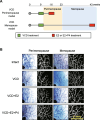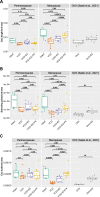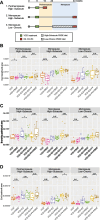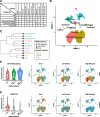Perimenopausal and Menopausal Mammary Glands In A 4-Vinylcyclohexene Diepoxide Mouse Model
- PMID: 39017946
- PMCID: PMC11254995
- DOI: 10.1007/s10911-024-09569-x
Perimenopausal and Menopausal Mammary Glands In A 4-Vinylcyclohexene Diepoxide Mouse Model
Abstract
As both perimenopausal and menopausal periods are recognized critical windows of susceptibility for breast carcinogenesis, development of a physiologically relevant model has been warranted. The traditional ovariectomy model causes instant removal of the entire hormonal repertoire produced by the ovary, which does not accurately approximate human natural menopause with gradual transition. Here, we characterized the mammary glands of 4-vinylcyclohexene diepoxide (VCD)-treated animals at different time points, revealing that the model can provide the mammary glands with both perimenopausal and menopausal states. The perimenopausal gland showed moderate regression in ductal structure with no responsiveness to external hormones, while the menopausal gland showed severe regression with hypersensitivity to hormones. Leveraging the findings on the VCD model, effects of a major endocrine disruptor (polybrominated diphenyl ethers, PBDEs) on the mammary gland were examined during and after menopausal transition, with the two exposure modes; low-dose, chronic (environmental) and high-dose, subacute (experimental). All conditions of PBDE exposure did not augment or compromise the macroscopic ductal reorganization resulting from menopausal transition and/or hormonal treatments. Single-cell RNA sequencing revealed that the experimental PBDE exposure during the post-menopausal period caused specific transcriptomic changes in the non-epithelial compartment such as Errfi1 upregulation in fibroblasts. The environmental PBDE exposure resulted in similar transcriptomic changes to a lesser extent. In summary, the VCD mouse model provides both perimenopausal and menopausal windows of susceptibility for the breast cancer research community. PBDEs, including all tested models, may affect the post-menopausal gland including impacts on the non-epithelial compartments.
Keywords: 4-Vinylcyclohexene Diepoxide (VCD); Breast Cancer; Mammary Gland; PBDEs; Single-Cell RNA Sequencing; Windows of Susceptibility.
© 2024. The Author(s).
Conflict of interest statement
The authors declare no competing interests.
Figures




Similar articles
-
Using 4-vinylcyclohexene diepoxide as a model of menopause for cardiovascular disease.Am J Physiol Heart Circ Physiol. 2020 Jun 1;318(6):H1461-H1473. doi: 10.1152/ajpheart.00555.2019. Epub 2020 May 8. Am J Physiol Heart Circ Physiol. 2020. PMID: 32383991 Free PMC article.
-
Single-cell RNA-sequencing analysis of estrogen- and endocrine-disrupting chemical-induced reorganization of mouse mammary gland.Commun Biol. 2019 Nov 5;2:406. doi: 10.1038/s42003-019-0618-9. eCollection 2019. Commun Biol. 2019. PMID: 31701034 Free PMC article.
-
ANG II-induced hypertension in the VCD mouse model of menopause is prevented by estrogen replacement during perimenopause.Am J Physiol Regul Integr Comp Physiol. 2015 Dec 15;309(12):R1546-52. doi: 10.1152/ajpregu.00170.2015. Epub 2015 Oct 21. Am J Physiol Regul Integr Comp Physiol. 2015. PMID: 26491098 Free PMC article.
-
Accelerated ovarian failure: a novel, chemically induced animal model of menopause.Brain Res. 2011 Mar 16;1379:176-87. doi: 10.1016/j.brainres.2010.12.064. Epub 2011 Jan 4. Brain Res. 2011. PMID: 21211517 Free PMC article. Review.
-
Hormonal fluctuations in rodent models using 4-vinylcyclohexene diepoxide: A systematic review and meta-analysis.Horm Behav. 2025 Feb;168:105680. doi: 10.1016/j.yhbeh.2025.105680. Epub 2025 Jan 17. Horm Behav. 2025. PMID: 39826372
Cited by
-
Methods and Models in Mammary Gland Biology and Breast Cancer Research.J Mammary Gland Biol Neoplasia. 2025 Mar 8;30(1):4. doi: 10.1007/s10911-025-09579-3. J Mammary Gland Biol Neoplasia. 2025. PMID: 40055275 Free PMC article.
References
-
- Kozlova EV, Chinthirla BD, Pérez PA, DiPatrizio NV, Argueta DA, Phillips AL, et al. Maternal transfer of environmentally relevant polybrominated diphenyl ethers (PBDEs) produces a diabetic phenotype and disrupts glucoregulatory hormones and hepatic endocannabinoids in adult mouse female offspring. Sci Rep. 2020;10:18102. doi: 10.1038/s41598-020-74853-9. - DOI - PMC - PubMed
-
- Ohajinwa CM, Van Bodegom PM, Xie Q, Chen J, Vijver MG, Osibanjo OO, et al. Hydrophobic organic pollutants in soils and dusts at electronic waste recycling sites: occurrence and possible impacts of polybrominated diphenyl ethers. Int J Environ Res Public Health. 2019;16:360. doi: 10.3390/ijerph16030360. - DOI - PMC - PubMed
MeSH terms
Substances
Grants and funding
LinkOut - more resources
Full Text Sources
Molecular Biology Databases
Research Materials
Miscellaneous

